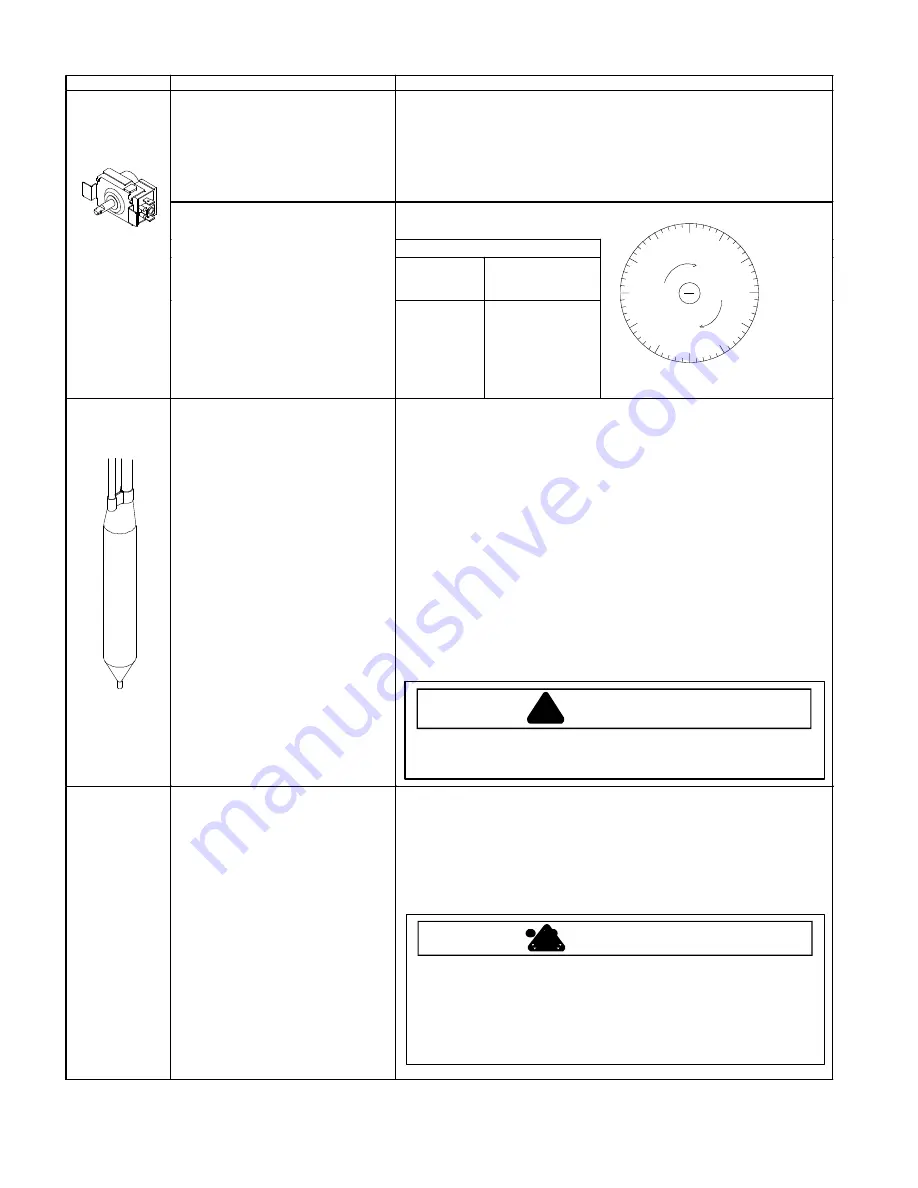
RS5280001 Rev. 0
26
Component Testing
Component
Description
Test Procedures
Freezer temperature control is a capillary
tube operating a single pole, single throw
switch.
Freezer temperature control controls run
cycle through defrost timer.
Check for proper calibration with thermocouple capillary in air supply well by
recording cut-in and cutout temperatures at middle setting. See tech sheet for
model being serviced for expected temperatures.
Check control contacts are opening by disconnecting electrical leads to control
and turning control knob to coldest setting. Check for continuity across terminals.
Altitude Counter in Feet
Meters (Feet)
Above
Sea Level
Turn Screw
Clockwise (Angular
Degrees)
Control, freezer
temperature
Altitude Adjustment
When altitude adjustment is required on
a G.E. control, turn altitude adjustment
screw 1/7 turn counter clockwise for each
304 meters increase in altitude up to
3048 meters One full turn equals 3048
meters maximum.
In most cases the need for altitude
adjustments can be avoided by simply
turning temperature control knob to
colder setting.
610 (2,000)
1218 (4,000)
1829 (6,000)
2438 (8,000)
3048 (10,000)
30
81
129
174
216
Drier
Drier is placed at post condenser loop
outlet and passes liquefied refrigerant to
capillary.
Desiccant (20) 8 x 12 4AXH - 7 M>S> -
Grams
Drier must be changed every time the system is opened for testing or
compressor replacement.
NOTE:
Drier used in R12 sealed system is not interchangeable with
drier used in R134a sealed system. Always replace drier in R134a
system with Amana part number B2150504.
Before opening refrigeration system, recover HFC134a refrigerant for safe
disposal.
Cut drier out of system using the following procedure. Do not unbraze drier.
Applying heat to remove drier will drive moisture into the system.
1.
Score capillary tube close to drier and break.
2.
Reform inlet tube to drier allowing enough space for large tube cutter.
3.
Cut circumference of drier 31.75 mm below condenser inlet tube joint to
drier.
4.
Remove drier.
5.
Apply heat trap paste on post condenser tubes to protect grommets from
high heat.
6.
Unbraze remaining part of drier. Remove drier from system.
7.
Discard drier in safe place. Do not leave drier with customer. If refrigerator is
under warranty, old drier must accompany warranty claim.
Evaporator
Inner volume of evaporator allows
liquefied refrigerant discharged from
capillary to expand into refrigerant gas.
Expansion cools evaporator tube and fin
temperature to approximately -29
°
C
(-20
°
F) transferring heat from freezer
section to refrigerant.
Passing through suction line to
compressor, the refrigerant picks up
superheat (a relationship between
pressure and temperature that assures
complete vaporization of liquid
refrigerant) as the result of capillary
soldered to suction line.
Refrigerant gas is pulled through suction
line by compressor completing
refrigeration cycle.
Test for leaks in evaporator with electronic leak detector or with soap solution.
Compressor oil is circulated with refrigerant; check for oil when checking for
leaks.
For minute leaks
1.
Separate evaporator from rest of refrigeration system and pressurize
evaporator up to a maximum of 9.65 bars (140 PSI) with a refrigerant and
dry nitrogen combination.
2.
Recheck for leaks.
CAUTION
!
To avoid death or severe personal injury, cut drier at correct location.
Cutting drier at incorrect location will allow desiccant beads to scatter. If
spilled, completely clean area of beads.
0
300
270
240
210
180
150
120
90
60
30
330
WARNING
!
To avoid severe personal injury or death from sudden eruption of
high pressure gases, observe the following:
•
Protect against a sudden eruption if high pressure are required
for leak checking.
•
Do not use high pressure compressed cases in refrigeration
systems without a reliable pressure regulator and pressure relief
valve in the lines.
















































